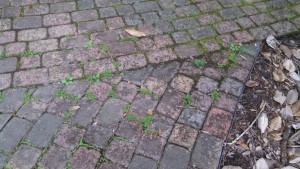Some of the more recent research into lawn science has focused on the people-yard relationship and how different management practices influence the lawns we see. Starting with the first of those, why do we put so much effort into lawns? Some researchers have suggested that our yards are a statement about how we want to be seen by others since front yards often get more attention than back yards (Daniels & Kirkpatrick 2006)- we’re judged by what can be seen from the road. The role of yards as status symbols was reflected by Larson et al. (2010) who found that, in an arid environment, more-affluent neighborhoods featured yards which combined desert landscaping with lush irrigated ‘oases’ of vegetation; the first type of yard is more reflective of the native environment, while the second is a traditional element of home ownership- combining the two is a statement about owner resources. Here in the US, having a green lawn with oak or elm or other shade trees is often linked to achievement of ‘the American Dream’ (Bormann et al. 2001). Lawns provide space for recreation and social interaction, and for some people they offer a connection to ‘nature’. This last quality is interesting because it leads to some behaviors which might seem counterintuitive. In Larson et al.’s (2010) study, participants who voiced ‘pro-environment’ views (meaning having concern for habitat loss, pollution, etc.) were more likely to have grass lawns despite living in an arid environment where grass lawns require more irrigation; these same grass lawns also received more fertilizer input than yards with native flora. For these landowners, ‘nature’ meant a green space, even in the desert.
What are the effects of our management choices? As I mentioned in my last post, mowing has the biggest impact on the ecosystem of our lawns. One thing that I noticed in reading these studies was that “mowing often” seems to be loosely defined- a study in Paris (Bertoncini et al. 2012) said that mowing was ‘highly frequent’ at 18-24 times a year which would translate into mowing 3-4 times per month for 6 months, while Thompson et a. (2004) included lawns mown every few days. In contrast, Pal et al. (2013) considered ‘regular mowing’ to be 1-2 times per month. What if your main concern is a lush, green lawn? Alumai et al. (2009) compared 4 types of lawn management: care from a commercial company, landowners using consumer lawn care products according to product recommendations, integrated pest management (which means that pesticides are not applied regularly, but when pest populations reach a certain level), and organic lawn care. Over three years of monitoring, lawns maintained by the commercial company had the lowest weed cover, lowest number of white grub pests, and highest lawn quality, but were also the most expensive to maintain. In contrast, the lawns which were managed following instructions from consumer lawn care products, while least expensive to maintain, had the highest levels of weed cover and lowest lawn quality. Alumai et al. (2009) suggested that the integrated pest management and organic options offered slightly lowered lawn quality, but were more economical than using a commercial company; in addition, the integrated pest management strategy had lower chemical inputs than the lawns managed by the commercial company and the organic lawns received inputs from corn gluten meal, boron, and feather-bone-soybean fertilizer instead of synthetic products.
In case you are wondering how more-traditional yard care systems compare with our mown green lawns, Pal et al. (2013) compared four types of yards in a Hungarian village: yards with mown grass, unmown yards that are driven on and trampled regularly, yards used for poultry grazing, and yards covered by pavers (bricks or stones). While trampled and poultry yards had the least plant species, mown and paved yards had the most. Driving and trampling compact the soil and reduce soil moisture, which can limit plant establishment and survival, while poultry selectively graze on the plants around them. In contrast, mown yards featured high grass diversity (generally non-native- probably because of the seed mixes used to establish the lawns) and paved yards had the most diverse plant communities in general. (Are you surprised by that last one? I was. But the cracks in between the pavers provide little microhabitats for plant establishment, and direct competition between plants is low since there are pavers separating them. Neat!)
So the choices we make in lawn design and care impact what plant and animal communities we see when we look outside- what are our best bets for getting the recreational spaces we want while also working with our local ecosystems? I’ll see what I can dig up for my final post.
Works cited:
Alumai, A, Salminen, SO, Richmond, DS, Cardina, J and PS Grewal. 2009. Comparative evaluation of aesthetic, biological, and economic effectiveness of different lawn management programs. Urban Ecosystems 12: 127-144.
Bertoncini, AP, Machon, N, Pavoine, S and A Muratet. 2012. Local gardening practices shape urban lawn floristic communities. Landscape and Urban Planning 105: 53-61.
Bormann, FH, Balmori, D and GT Geballe. 2001. Redesigning the American lawn: a search for environmental harmony, 2nd ed. Yale University Press: New Haven.
Daniels, GD and JB Kirkpatrick. 2006. Comparing the characteristics of front and back domestic gardens in Hobart, Tasmania, Australia. Landscape and Urban Planning 78: 344-352.
Larson, KL, Cook, E, Strawhacker, C and SJ Hall. 2010. The influence of diverse values, ecological structure, and geographic context on residents’ multifaceted landscaping decisions. Human Ecology 38: 747-761.
Pal, RW, Csete, S, Botta-Dukat, Z and G Pinke. 2013. Composition and diversity of lawn flora in differently managed village yards- a case study from southwestern Hungary. Folia Geobotanica 48: 209-227.
Thompson, K, Hodgson, JG, Smith, RM, Warren, PH, and KJ Gaston. 2004. Journal of Vegetation Science 15: 373-378.

